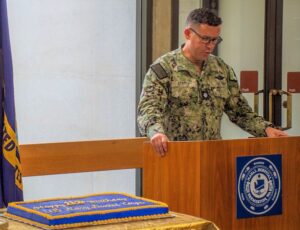
Story by Douglas Stutz
Naval Hospital Bremerton/Navy Medicine Readiness and Training Command Bremerton
For 112 years – and counting – they’ve been the substance behind Sailor smiles.
The Dental Corps team assigned to Navy Medicine Readiness Training Command Bremerton celebrated their August 22, 1912, birthdate as part of that skill set delivering the preventive dental care needed for Navy and Marine Corps operational readiness.
Along with so much more.
Dental Corps officers serve at military treatment facilities, clinics, hospitals and ships with Navy and Marine Corps squadrons, battalions, and Seabee detachments, combat operations, disaster relief efforts and humanitarian missions,” said Cmdr. Diane Vo, NMRTC Bremerton senior dental executive. “By providing regular exams, preventive care, and treatment of urgent dental concerns, the Dental Corps works to ensure operational dental readiness, removing one variable mitigating mission success, which allows our Sailors to be more effective and, “putting the Bite in the Fight.”
NMRTC Bremerton Dental, along with assets at branch health clinics located on Naval Base Kitsap Bangor and Naval Station Everett, deliver a host of dental services such as general and comprehensive dentistry, oral and maxillofacial surgery, oral maxillofacial radiology, endodontics, prosthodontics, digital dentistry and dental hygiene.
“Dental services streamline efforts to take care of our empaneled Sailors efficiently and effectively. We leverage operating room capabilities at NMRTC Bremerton, digital dentistry and lab fabrication workflows at Navy Medicine Readiness Training Unit Bangor, dependent on patient care needs to optimize the quality of care provided,” explained Vo.
There are 13 active duty dentists, two civil service dentists, and nine contracted dental hygienists who delivered care to over 12,300 active duty beneficiaries in 2023. The dental team also provided dental services to multiple Navy platforms during Selected Restricted Availability, Refueling and Complex Overhaul periods.
Notably, the dental team has been able to leverage advancements in virtual surgical planning and 3D printing to perform full mouth rehabilitation, reducing multiple surgeries required for each case down to one, increased surgical predictability, and minimized Sailors’ time away from their deploying operational platforms.
There were more than 30,400 patient encounters in 2023, along with ensuring dental readiness for approximately 120 commands with the Command’s Operational Dental Readiness for the end of 2023 at 97 percent, two percent above the Navy benchmark. The total force ODR was at 91 percent. Yet it can be challenging at times.
“Operational demands, whether training, inspections, or a myriad of other obligations are critical to ensure mission success. These often must be balanced with personal readiness. This is very palpable as we support many operational units that do not have organic dental assets,” Vo remarked, noting that the importance of oral hygiene and dental care is recognized as a vital part of not just individual health, but also essential to a command’s mission.
“Leadership engagement and support is critical to balancing work obligations to ensure Sailors are able to schedule and observe dental appointments to meet operational readiness,” stressed Vo.
Although dental health is derived from the basic foundation of preventing cavities and stressing the need to brush and floss regularly, it’s more than that. Towards that end, the Navy’s dental readiness classification system helps as an integral gauge of every command’s operational readiness.
Dental classification is critical as a diagnostic tool.” Vo noted. “It allows us to evaluate or anticipate dental issues to prioritize need. This directly contributes to success downrange so that our Sailors can stay engaged in the fight and mitigates unexpected dental issues.”
Class I: A patient is good to go with no dental treatment expected in a year.
Class II: A patient may need minor or elective treatment such as a dental cleaning or a small filling.
Class III: A patient has some sort of active dental disease, such as a cavity and the decayed part of the tooth must be removed and filled, or it could get much worse within a year.
Class IV: A patient hasn’t had a dental exam within the year [A lot can happen in that time…].
It was on August 22, 1912, when President William Taft signed the bill authorizing Secretary of the Navy George Von Lengerke Meyer “to appoint not more than 30 acting assistant dental surgeons to be part of the Medical Department of the U.S. Navy.”
The primary responsibility of Navy dentists back then is the same today; to maintain high operational readiness and train for all contingencies.
Dental Corps officers – and dental technicians with specialty training as dental assistant and dental hygienist – routinely deploy with Marine Expeditionary Units, Navy fleet assets as well as humanitarian missions like Pacific Partnership.
Navy Medicine’s approximately 1,300 active duty and reserve dentists are accomplished in 15 specialties which include such disciplines as comprehensive dentistry, dental and biomedical research, dental public health, endodontics, forensic odontology, maxillofacial prosthetics, operative dentistry, oral and maxillofacial pathology, oral medicine and radiology, orofacial pain, orthodontics, pediatric dentistry, periodontics, oral and maxillofacial surgery and prosthodontics.
The Dental Corps officers are ably assisted by Hospital Corps Sailors with specialty training as dental assistant and dental hygienist where they perform basic duties such as dental infection control, dental treatment room management, preventive dentistry, comprehensive dental assisting, and intraoral radiography.
All specifically designed to bring a smile to every Sailor.